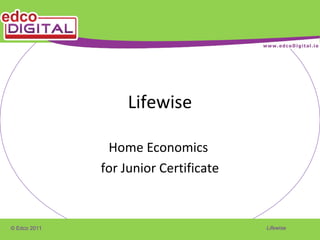More Related Content
Similar to Ahe7042s chapter1
Similar to Ahe7042s chapter1 (20)
Ahe7042s chapter1
- 1. © Edco 2011 Lifewise
Lifewise
Home Economics
for Junior Certificate
- 3. © Edco 2011 Lifewise
Functions of food
• Food helps the body to grow
• Food provides the body with energy
and warmth
• Food protects the body against
disease
- 4. © Edco 2011 Lifewise
Nutrition: important terms
• Nutrient – a chemical in food that nourishes
the body, e.g. protein
• Composition – what the nutrient is made of
• Source – a food that contains the nutrient
• Function – what the nutrient does in the body
• Recommended dietary allowance (RDA) –
the amount of the nutrient we should eat each
day
• Deficiency disease – ill effects that are
caused by lack of the nutrient
- 5. © Edco 2011 Lifewise
Nutrients
• A nutrient is a
chemical in food that
nourishes the body
• Although water is not
regarded as a
nutrient, it is
essential for life
• There are six types
of nutrient:
– proteins
– vitamins
– fats
– minerals
– carbohydrates
– water
- 6. © Edco 2011 Lifewise
Macronutrients and
micronutrients
• Proteins, fats and carbohydrates are
macronutrients: they are needed in large
amounts
• Vitamins and minerals are
micronutrients: they are needed in small
amounts
- 7. © Edco 2011 Lifewise
Proteins
• Proteins are made up of amino acids
• Amino acids are made up of carbon,
oxygen, hydrogen and nitrogen
- 8. © Edco 2011 Lifewise
Classification of proteins
Foods containing high biological
value protein
Foods containing low biological
value protein
• Meat
• Fish
• Eggs
• Milk and dairy produce
• Soya beans
• Quorn
• Peas
• Beans
• Lentils
• Nuts
• Whole cereals
• Muesli
- 9. © Edco 2011 Lifewise
Functions of protein
• Helps body cells to grow
• Helps the body repair damaged cells
• Forms hormones and enzymes
• Used for heat and energy when there are
not enough energy foods in the diet
- 10. © Edco 2011 Lifewise
Fats
• Fats are made from
fatty acids and
glycerol
• Each molecule of
glycerol is attached
to three fatty acids
• Glycerol and fatty
acids contain carbon,
hydrogen, oxygen
Composition of fats
- 11. © Edco 2011 Lifewise
Sources of fats
Saturated fats Unsaturated fats
Mainly from animal sources From plant and marine sources
• Butter
• Meat
• Milk and cream
• Cheese
• Eggs
• Suet
• Sunflower oil
• Olive oil
• Nuts
• Seeds
• Polyunsaturated margarine
• Fish oils
• Oily fish
- 12. © Edco 2011 Lifewise
Functions of fats
• Provide heat and energy
• Contain vitamins A, D, E, K
• A layer of fat under the skin insulates the
body
• Protect delicate organs
• Delay the feeling of hunger
- 13. © Edco 2011 Lifewise
Carbohydrates
• Made up of simple
sugars
• Simple sugars join
to form starch
• Carbohydrates
contain carbon,
hydrogen and
oxygen
• Composition of
carbohydrates
- 14. © Edco 2011 Lifewise
Sources of carbohydrates
Sugars Starches Dietary fibre
• Fruit (fresh and dried)
• Milk
• Cakes, biscuits
• Soft drinks
• Jam
• Ice cream
• Honey
• Sugar
• Cereals
• Potatoes
• Root vegetables
• Pulse vegetables
• Vegetables
• Fruit
• Brown rice
• Brown bread
- 15. © Edco 2011 Lifewise
Fibre
• Fibre absorbs water and becomes bulky
in the intestine
• This prevents constipation and other
bowel diseases
• RDA for fibre: 30g for an average person
- 16. © Edco 2011 Lifewise
Vitamins
• Vitamins are needed in small amounts
• They are divided into two groups:
– Water-soluble: vitamin B group and vitamin C
– Fat-soluble: vitamins A, D, E and K
- 18. © Edco 2011 Lifewise
Water
Sources of water
• Tap or bottled water
• Drinks such as milk, tea,
coffee
• Most foods contain water
Functions of water
• Satisfies thirst
• Helps digestion
• Helps remove waste
from the body
• Source of fluoride and
calcium
• Part of all body fluids
- 19. © Edco 2011 Lifewise
Energy
Energy from food
• The body’s cells burn
food and produce
energy. This is called
oxidation
• Energy in food is
measured in kilocalories
or kilojoules
• 1 kcal = 4.2 kJ
Energy requirements
depend on:
• Size
• Age
• Activity levels
• Climate
• Gender
• Pregnancy
- 20. © Edco 2011 Lifewise
Energy balance
• Energy input should
be equal to energy
output
• Extra energy is
stored in the body as
fat
• Too little energy can
lead to a person
being underweight
